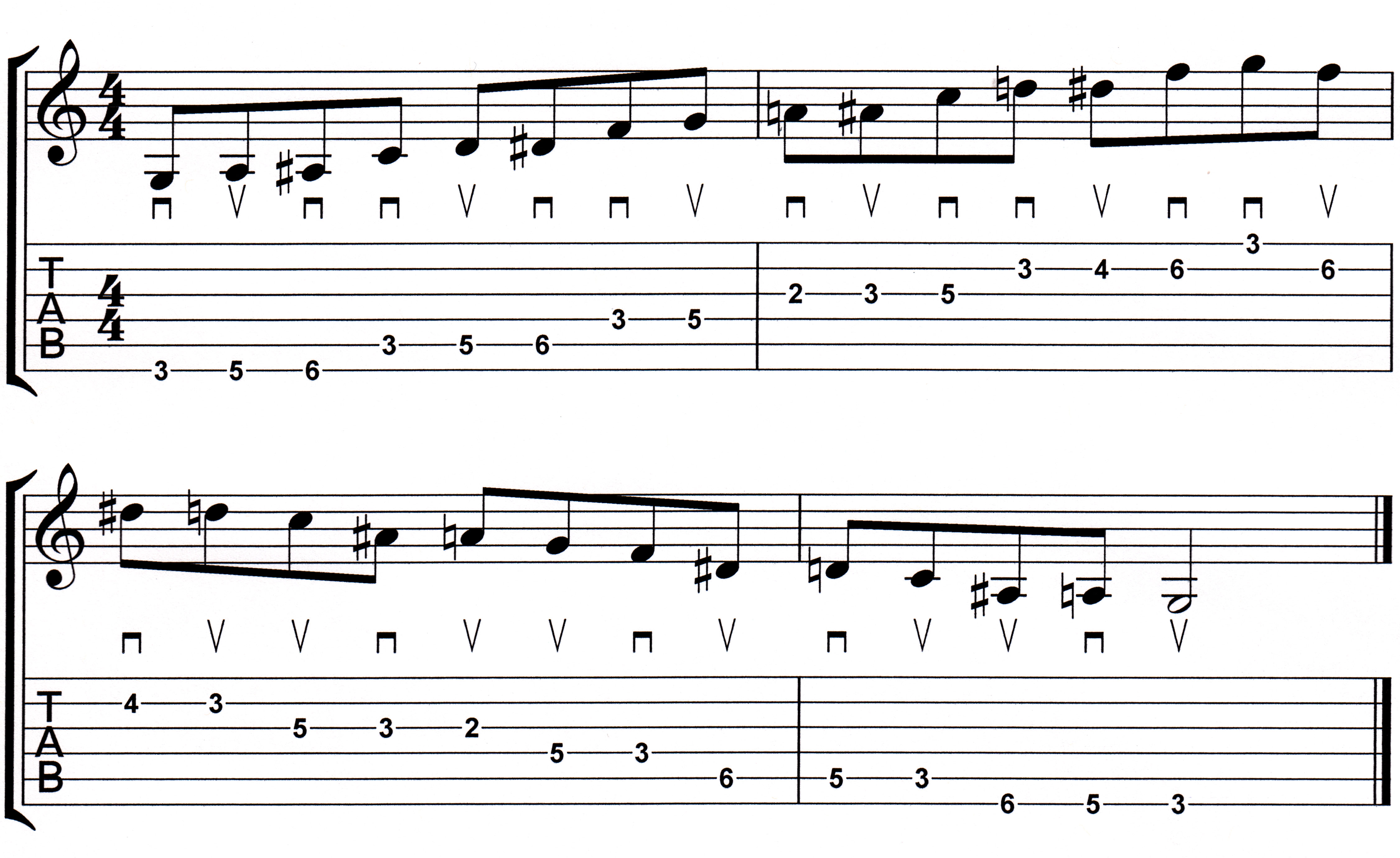
Just as it is important to know the Major scale (Ionian mode), it is likewise important to know the Pure Minor scale (Aeolian Mode). We are not talking
about the Pentatonic Major or Pentatonic Minor scales, but modal scales. While it is important to know the Pentatonics, often being the first scales
guitar players actually learn, they tend to be lacking in the richness of tonal colour. And that's where knowing modes benefits your melodic efforts.
So the Pure Minor scale, shown below in the key of G, is the quintessential minor scale you really need to know, especially if you are playing a lot of minor rooted
songs. Note also the picking instructions; it outlines an approach called "economy picking", touched on last lesson, and a means of using the least amount of motion to most efficiently play a
passage.

As with the Major scale lesson, you want to use the most practical approach to playing this scale. We employ a general "one finger - one fret" rule as much as possible. But with this scale, at least in the above example, you need to shift your fingering a bit.
And, remember to employ the other device used by Classical stringed instrument players, the hovering! When ascending the scale, you want to keep your fingers on the strings. Do not lift them off:
It is here you need to make a decision to accommodate the shift you will make to the 3rd string. As you play the octave G tone on the fourth string, you can do so with your 3rd finger, thus requiring a real stretch to the second fret of the 3rd string with your first finger. Alternatively, you can use your 4th finger on the octave G tone so your stretch to the 2nd fret of the third string with your 1st finger will be more natural and easy.
You would then shift back to your first finger on the 2nd string at the third fret and continue up to the second octave high G tone.
It may sound hard, but it is not difficult at all. If you've been playing without this discipline it will take a little focused effort to change your method. Just remember to work on smooth and even note flow, letting each note have its full measure of sound and time.
As you descend down the scale, play exactly backwards the way you played while ascending. Obviously you have to lift a finger off the string to sound the next lower note on the same string, but - just a couple millimeters, no more. They have to be ready for the next note they’ll be playing, regardless of which direction your ultimately are headed. Descending licks tend to be easier to play for some reason, but that is no excuse to not focus on smooth and even sounding notes regardless of direction you are playing!
You should always use a metronome to help you play smooth and even. Set it at a speed slower than you think you need, especially if you’ve never played this scale before. And even if you have, but are new to the idea of leaving fingers on the strings, slow it down and get it right. You need to learn to synchronise left and right hands to work together.
Once you are reasonably fluent, speed up no more than four beats per minute at a time until you master each tempo – which will preserve technique. Then you can advance to the next tempo. You want to bring technique and clarity forward in your progress; it would be a shame to leave technique in the dust in favour of speed and slop.
NOTE: Practice this and all articulation and speed exercises with lower volume and clean tones, not loud and distorted. You want to hear everything. It is the only way you’ll truly know your playing is correct.
The reason you want to learn this technique is so that your fingers will always be ready to perform whatever task they are asked to play, and there will be minimal movement required to do that - at least in that position. The same idea can be applied to chords, too, in the sense that you want your fingers hovering just off the strings as you move from one chord to another.
The primary benefit beyond good technique is that your speed will begin to increase, your fluid motion will improve, both in legato phrasing and chord changes you employ.
Much said in the Major Scale lesson is repeated here, and with good reason. The technique discussed is very specific and takes a little effort to adopt as part of your playing style. Take the time and you will be richly rewarded with increased clarity and tone.
Okay, now shut off your computer and go play with some ideas.
See you next time.